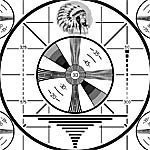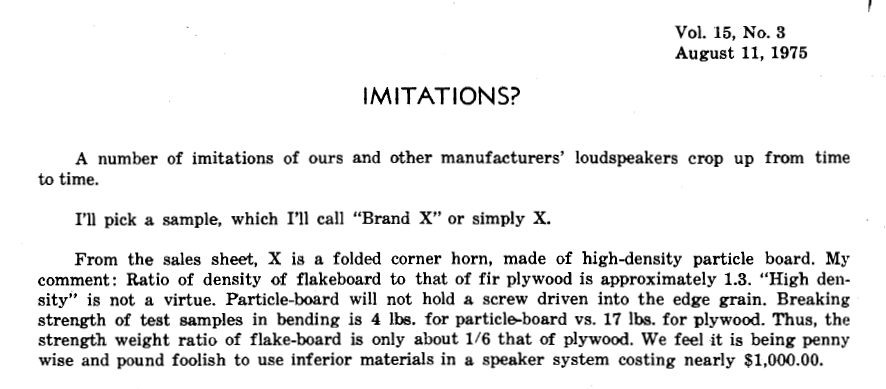-
Posts
212 -
Joined
-
Last visited
Content Type
Forums
Events
Gallery
Everything posted by Endo
-
Don't know what part of the country you're in, but CL in Boulder, CO has some CF3 v1: https://boulder.craigslist.org/ele/6184360578.html And also a pair of CF2 v?, in "Denver": https://denver.craigslist.org/ele/6207003723.html ! EDIT: Ok. so I went back and actually read the ad. This is just too funny: " The Epic series was Klipsch's one-and-only audiophile speaker series" -- WTF? -- (I'm laughing now, so I guess I have to "like" my own post.) Where is the tar and feathers? Does someone know where the tar and feathers are kept?
-
Russian baltic birch is good stuff. Available in various grades--its widely used throughout North America for better quality cabinets and casework; especially in drawer boxes where there is zero tolerance for voids. Russian BB is a creature unto itself. I have never seen a void in sheets that were spec'd void-free. For structural integrity, a careful shopper might find a "close" equivalent--but for what it claims to be... I've never seen better, at any price. (To re-iterate previous posts: "multi-ply" and "super-ply" products may look like BB; be cautious). I do not doubt that K.A. was experiencing quality control issues with their custom material from a North American supplier--but for anyone looking to invest the very considerable time and effort required for a quality speaker build--I would not skimp on the sheet material; and certainly would include Russian Baltic Birch among the better materials available. In addition to the common 5x5' sheets, in 3, 6, 9, 12, 15, and 18mm;--I have also seen it as thick as 24mm (~1 inch) thick and as large as 4x8'. ^ A cabinet grade plywood could be a substitute; but it is not a replacement, and it will not perform like BB. "Multi-ply" and "SuperPly" are tradenames for products similar to BB, and would be an improvement over a standard, mixed-fir, cabinet-grade ply. If you've got a particular species, or grain pattern in mind--you might try to find a supplier to special order one of the available 'multi-ply' products that is already faced with the veneer. Otherwise, a BB build that you face with veneer yourself would allow you to hand-select the veneer; and might yield best possible results. This could be a source of satisfaction, you would enjoy for the life of the speaker. [As an aside: remember that different materials will likely mean different methods of joinery; miters, 'lock joints', glues and mechanical fasteners are all optimized for specific materials and may not "play well with others" (eg. stapling plywood may work, where the identical joint in MDF fails. So, if you follow plans that spec both materials and fasteners, changing materials could also mean changing fasteners/joints)] I thought others reading this thread might be interested in the Dope excerpt, below. MDF is not mentioned, by name, but the principles discussed are as true today as they were then. Screws holding in edge grain, "high-density", breaking strength, stiffness... these all apply to MDF; in some ways even more so.
-
Goosebumps? Listen to David McCullough read from his own book, 1776, the story of men slogging the Gun [Goosebumps happening right now, just thinking... happened again] Anyway, listen to him read the account of the men slogging the Guns of Ticonderoga to their destination [bumps again] [more bumps... ] This stuff should be taught in grade school; then again in middle school; and high school. There should be a friggin' national holiday for this. The Guns of [bumps] Ticonderoga
-
Regarding ceiling bounce: Dope from Hope, Dec. '60; PWK writes about Dr. Boner's convex designs in masonite. I realize these may not be practical for a lot of us; but imagine if there were another material, like maybe cloth with batting of some kind? Just a thought. The ceiling has always seemed to me as one of the largest players in this game that gets the least attention.
-
Earlier comments reminded me of this video [disclaimer: this is not a Klipsch setup]: It may be a bit of a non-sequitor at this later stage of the thread, but mention of Mr. Abe's listening room would seem appropriate to any conversation regarding "acoustically large" speakers in a small space; While I cannot articulate the reasons--, it seems to depart from prevailing wisdom, (jump to 6:30 ~7:30, to get camera pan of room); do the floor-to-ceiling, album-lined shelves contribute to rooms effectiveness?... : Strikes me as inspired. Well considered.
-
That oiled walnut/fabric combo is gorgeous. Sets-off the copper badge nicely.
-
Whoooa, boy... I love this place. Conversations like this one are what life is all about! No one advances in a vacuum (I'm laughing at myself now, the pun was unintended). BTW--beautiful amp. Anyone bringing that level of finish and finesse to a product is probably producing a labor of love. MW's story about the inspiration behind the amp: very cool.
-

"pop" sound plays through speakers when amp switched-off.
Endo replied to Endo's topic in Talkin' Tubes
Thank you. This works. The pop still happens, but much quieter--not soiling my pants, as before. Thanks for pointing this out. I'll be sure to ask about this when I speak with the tech. I'm wondering if it was imported for sale in this country--or did somebody just bring this one in. I can't find anything about it on the web, like its uncommon here in the U.S. -

"pop" sound plays through speakers when amp switched-off.
Endo replied to Endo's topic in Talkin' Tubes
^Thank you, everybody, for the helpful info. This is a curious little amp. Japanese, single ended with 6MB8 output; each channel has separate gain, separate tone. Inputs for two phonos, tape and tuner. Don't know if tubes are configured triode or pentode (is this discernible?). Externally, the design looks 1960s. Cannot find anything online. The last tech to work on it was Mike Zuccaro, in San Diego. I'm waiting to hear back from him. -

"pop" sound plays through speakers when amp switched-off.
Endo replied to Endo's topic in Talkin' Tubes
^ Thank you. For what its worth, the gain had no affect on the loudness of the pop. Don't know if this means anything. I'm just wondering if I need to be concerned? Sounds like maybe not? -
I've never experienced this before, with any other amps. Don't know if its tube related, or not; but it happens to be a tube amp, so I'm posting this here... Brought home a used amp. First time I switched-off the power, I heard a "pop" play through both speakers (loud enough to cause concern). After a long pause (during which I did nothing but hesitate, as my hands began to sweat), I powered the amp back up until everything was glowing, then turned gain back to zero, and switched the power off. It happened again, the same as before. Do I need to be concerned? Anyone have experience with this sort of thing?
-
I heard Oscar The Grouch has a weekend home in Maine; maybe they're his. (be nice)
-

Ultimate turntable tweek - this one takes the Cake
Endo replied to richieb's topic in 2-Channel Home Audio
Too funny. I live by a self-imposed rule: If somebody's posting makes me laugh out loud (above noise floor), I must click the "Like this" button before I stop. New record established. -
^ I see. Given the disparity in watts--what other factors (besides damping) would account for the lower power amp doing a better job? This has my curiosity--is it the power supply, or the output transformers, or... tube choice? A separate issue, but: the 2.7 Ohm load at the speaker is going to present more difficult damping than an 8 Ohm load, all else being equal. Correct? Like a few others, I'm about to make a first leap into the world of tubes. I find all of this interesting. As somebody who doesn't have a lot of money to burn--I find these exchanges helpful. I love this place.
-
Before reading this, I didn't know Ohms were directly related to damping. At least that part makes sense now. Stopping and starting anything is going to be more difficult if there is more of it to contend with, I guess. Not the same, I'm sure; but, reminds me of inertia. EDIT: High impedence headphones... Oooooh, I see.
-
^ Schu and derrickdj1, Thank you. I've been reading about damping factor--makes about as much sense to me as vinyl grooves storing hi-fi audio signals. At least, now, I have an awareness for it.
-
Question: Can anyone help me understand what makes some amps with fewer watts sufficiently power a (larger) driver that other, more powerful amps cannot? What else is going on (besides watt ratings) that accounts for this difference? EDIT: Larger output transformers? Power supply?--Is that the difference? If so, can you tell by looking at the spec sheet? What does that look like?
-
^Nice. Another benefit of buying the kind of quality that outlives you is the legacy made available to others (reminds me of some speakers I have)
-
I have never regretted spending too much on quality tools; but I have regretted not spending enough. The latter can be a complete waste of money. Anybody ever heard the saying "the cheapskate spends the most?"; or "buy the best and only cry once!" Buy the best tools you can afford--which is going to be different for everybody. Edit: But also, I would never buy a Festool anything if I thought I was going to use it once or twice and shelve it forever--that would also be a kind of waste... So I appreciate the dilemma.
-
I made the mistake of responding to your post about wheelies without reading through the remaining thread... Others had already made the suggestion of backing up the ramps in reverse. I felt a little silly... like there was toilet paper stuck to my shoe, or something.
-
[Deleted]
-

Who wants to measure how much power (voltage) is REALLY needed?
Endo replied to tube fanatic's topic in 2-Channel Home Audio
Am I reading this chart correctly? Are the listed numbers the "amplifier power rating... required to generate average sound pressure levels WHILE ALLOWING peaks 10 dB above average to pass without clipping" ? I was thinking the power listed is sufficient to handle the peaks? Have I got this wrong? Edit: In other words, 6.3 watts will drive Khorn, LS, BK to both an average 105 SPL and also peaks 10 dB above... without clipping. [?] -

Who wants to measure how much power (voltage) is REALLY needed?
Endo replied to tube fanatic's topic in 2-Channel Home Audio
I ran across this today as I was reading through Dope-from-Hope articles (Vol.16, No. 1). I thought it might be of interest to anyone reading this thread. Chance to see how our individual experience squares with previous findings. I especially like PWK's notes/commentary on the left margin that describe the increasing sound levels: -
Yes, exactly. Not knowing more than I do (a little knowledge is a dangerous thing, right?), I am imagining 'pseudo-monoblock' where they're simply wired/configured that way. My question is whether or not the bass performance might improve with two dedicated units over single stereo one.

.jpg.7f454f5d60031f79a3d59a8e49e18270.jpg)



